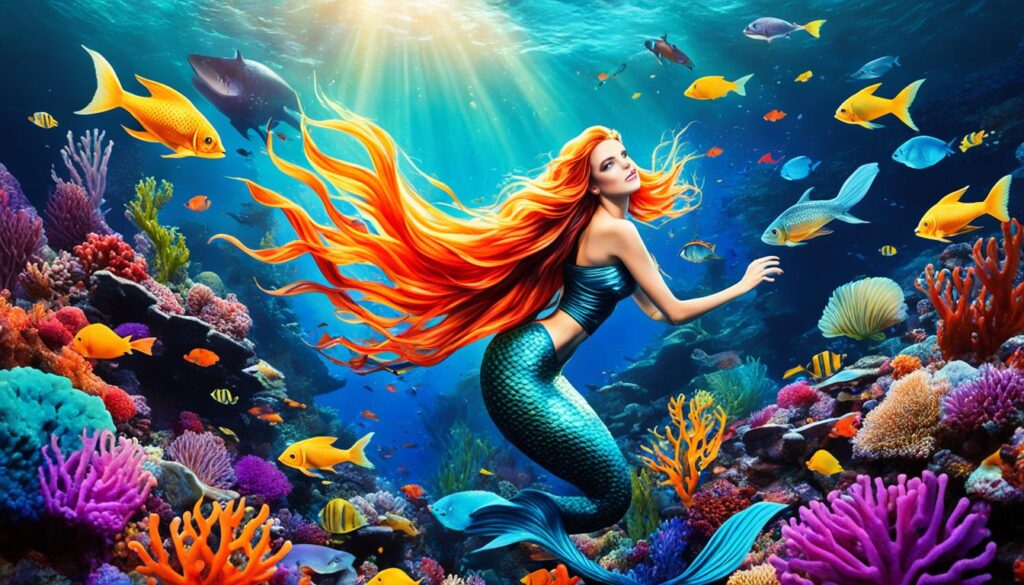Mermaids, those fascinating half-human and half-fish creatures, have captured the imaginations of maritime cultures for centuries. From ancient texts to folklore from around the world, these underwater beings have become the stuff of legend. But the question remains: are mermaids real?
Despite countless stories and sightings, there is no concrete evidence of the existence of these mystical creatures. Yet, the belief in mermaids persists, fueled by the allure of marine mysteries and the captivating power of myth. Let’s dive deeper into the origins of mermaid legends, the symbolism they hold, and the impact they have had on human culture and storytelling.
Key Takeaways:
- Mermaids have been part of maritime cultures for centuries, but their existence has never been proven.
- Legends of mermaids can be traced back to ancient civilizations and have evolved in different cultures throughout history.
- Mermaids have been symbols of beauty, mystery, and the unexplainable.
- Popular folklore and literature, such as “The Little Mermaid,” have shaped our perception of mermaids.
- Many mermaid sightings can be explained by misidentifications, optical illusions, and hoaxes.
Origins of Mermaid Legends
The origins of mermaid legends can be traced back to ancient civilizations, such as the ancient Greeks and Assyrians. In Greek mythology, mermaids were associated with divine figures and portrayed in stories as either benevolent or mischievous creatures. In Assyrian folklore, the goddess Atargatis is said to have transformed herself into a mermaid. Throughout history, different cultures have had varying perspectives on mermaids, viewing them as enchanting beings or harbingers of disaster.
The Power of Myth and Symbolism
Mermaids have captivated the human imagination for centuries, representing the supernatural beings that embody the mysteries of the sea. These mesmerizing creatures have been used as symbols to explain the unexplainable, evoking a sense of wonder and awe.
Throughout history, mermaid sightings have been reported, adding to the marine mysteries that have intrigued mankind. Many of these sightings, however, can be attributed to misidentified animals like manatees, leading to the perpetuation of mermaid myths. Despite the scientific explanations, the allure of mermaids and their association with the unknown continues to capture the fascination of people around the world.
Stories of mermaid encounters have been passed down through generations, contributing to the rich tapestry of cultural mythology. From their representation of grace and beauty to their embodiment of the mysteries hidden beneath the waves, mermaids hold a special place in our collective consciousness.
While skeptical explanations exist for mermaid sightings, the enduring power of these mythical creatures cannot be denied. They serve as a reminder of our innate human curiosity, our desire to explore the unknown, and our appreciation for the beauty and wonders of the ocean.
Famous Mermaid Sightings in History
| Date | Location | Description |
|---|---|---|
| 1830 | Fiji | Several witnesses report seeing a mermaid swimming near the coast, described as having a fish-like tail and a human-like upper body. |
| 1912 | Scotland | A sailor claims to have encountered a mermaid while on his fishing boat, describing the creature as having long, flowing hair and sparkling scales. |
| 1967 | USA, California | A group of beachgoers spot a figure in the water that resembles a mermaid, but upon closer inspection, it turns out to be a playful seal. |
These documented mermaid sightings highlight the enduring allure and intrigue surrounding these mythical beings, and their appearance in various cultures’ folklore. Whether real or simply the product of human imagination, mermaids continue to captivate our minds and hearts, serving as a reminder of the vast mysteries that lie beneath the ocean’s surface.
The Influence of Folklore and Literature
Mermaids have played a significant role in shaping our collective imagination through folklore and literature. Iconic tales like Hans Christian Andersen’s “The Little Mermaid” and its popular Disney adaptation have captured the hearts of audiences worldwide, presenting mermaids as fascinating creatures with a longing for human existence and adventure.
These enchanting stories have not only entertained generations but have also shaped our perception of mermaids and their mythical qualities. The Little Mermaid, a tale of sacrifice and the pursuit of true love, has become synonymous with mermaid tales, intricately weaving imagination and emotion together.
Mermaid myths and tales continue to be celebrated and passed down through generations, firmly establishing mermaids as beloved figures in popular culture. The enduring fascination with these legendary creatures is a testament to their enduring appeal and the timeless power of storytelling.

| Mermaid Literature | Description |
|---|---|
| Hans Christian Andersen’s “The Little Mermaid” | An iconic story of a mermaid’s desire for a human soul and her sacrifice for love. |
| Disney’s “The Little Mermaid” | A beloved animated film adaptation that brought the mermaid tale to a wider audience and popularized the character of Ariel. |
| Mermaid Tales and Legends from Around the World | A collection of stories from various cultures, each showcasing unique interpretations and characteristics of mermaids. |
Realistic Explanations for Mermaid Sightings
While mermaid sightings have fascinated people for centuries, many of these encounters can be attributed to mermaid misidentifications, optical illusions, and hoaxes. It is important to approach these stories with a critical eye and consider alternative explanations before jumping to supernatural conclusions.
Misidentifications of Marine Life
One common explanation for mermaid sightings is the misidentification of marine mammals, such as manatees and dugongs. These creatures have been known to inhabit coastal waters and bear a resemblance to the mythical mermaids. Their rounded bodies, flipper-like limbs, and curious behaviors may have contributed to mistaken identity in certain cases.
For instance, Christopher Columbus himself reported seeing “mermaids” during his voyage to the Americas in 1493. However, it was later revealed that he had likely encountered manatees or similar marine animals. The confusion may have arisen due to the sailors’ lack of familiarity with these unique creatures.
Optical Illusions on the Water
Optical illusions can play tricks on the human eye, especially when observed in challenging environments such as the vast expanse of the ocean. Certain lighting conditions, such as the reflection of sunlight or moonlight on the water’s surface, can create shimmering effects and distortions that resemble mermaid-like figures.
Imagine standing on the shore at dusk, observing the setting sun casting its golden hues on the tranquil sea. In this moment, the interplay of light and water may conjure up ethereal images that seem otherworldly. While these illusions can spark the imagination, it is crucial to differentiate between what the eye sees and what is actually present.
Hoaxes and Folklore Influence
Throughout history, hoaxes have perpetuated the belief in mermaids. Clever individuals seeking attention or amusement have fabricated stories and created elaborate hoaxes, often supported by fictional photographs or eyewitness accounts. These tales capture the public’s imagination and add to the mystique surrounding these mythical beings.
Furthermore, the influence of folklore and popular culture cannot be understated. Mermaids have been prominent figures in literature, art, and cinema, further blurring the lines between myth and reality. Familiarity with mermaid tales, such as Hans Christian Andersen’s “The Little Mermaid,” can unconsciously shape our perception of what we expect to see when encountering something unusual in the water.
By considering these realistic explanations, we can approach mermaid sightings with a rational mindset. While the allure of mermaids persists, it is essential to separate fact from fiction and embrace critical thinking when exploring the mysteries of the deep sea.
| Realistic Explanations for Mermaid Sightings | Considerations |
|---|---|
| Misidentifications of Marine Life | Manatees and dugongs can bear a resemblance to mermaids, leading to mistaken identity. |
| Optical Illusions on the Water | Lighting conditions and reflections can create shimmering effects that resemble mermaid-like figures. |
| Hoaxes and Folklore Influence | Hoaxes perpetuate the belief in mermaids, while folklore and popular culture contribute to the collective imagination. |
Conclusion
While the existence of mermaids has never been proven, their enduring presence in folklore and mythology showcases the enduring power of the human imagination. Mermaids continue to capture our interest and curiosity, representing the allure and mystery of the ocean.
Whether as mythical creatures or symbols of beauty and wonder, mermaids hold a special place in our cultural consciousness. Their enchanting tales have been passed down through generations, weaving together a tapestry of mermaid folklore and ocean legends.
Although scientific evidence may suggest otherwise, the fascination with mermaids persists. Their ethereal allure, depicted in art, literature, and popular culture, keeps the mermaid myth alive. As we dive deeper into the realm of fantasy and maritime legends, mermaids will remain an integral part of human storytelling and imagination.
FAQ
Are mermaids real?
No, there is no scientific evidence to support the existence of mermaids.
Where do mermaid legends come from?
Mermaid legends can be traced back to ancient civilizations such as the Greeks and Assyrians.
Do mermaids have a symbolic meaning?
Yes, mermaids have been used as symbols to represent beauty, grace, and the mysteries of the sea.
Are there any famous stories or tales about mermaids?
Yes, iconic tales such as “The Little Mermaid” by Hans Christian Andersen have made mermaids well-known in popular culture.
Have there been any real mermaid sightings?
Most reported mermaid sightings can be explained as misidentified animals, optical illusions, or hoaxes.
Are mermaids just a product of folklore and imagination?
While mermaids are not real, their presence in folklore and mythology showcases the enduring power of human imagination.







